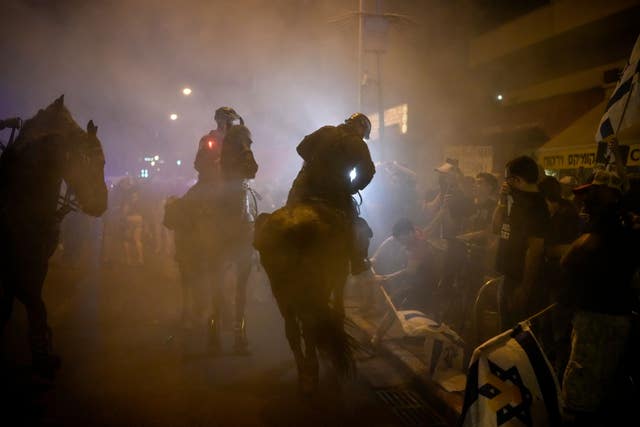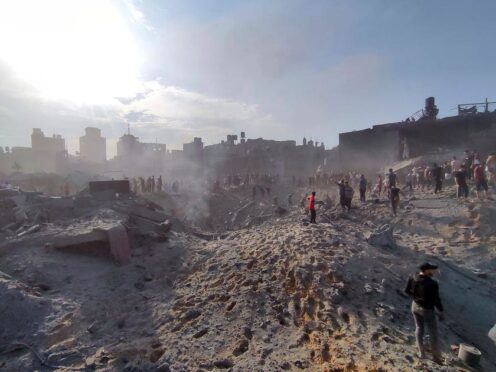The viability of a US-backed proposal to wind down the war in Gaza has been cast into doubt after Israeli Prime Minister Benjamin Netanyahu said he would only be willing to agree to a “partial” ceasefire deal that would not end the conflict.
His comments sparked an uproar from families of Israeli hostages held by Hamas.
In an interview broadcast late on Sunday on Israeli Channel 14, a conservative, pro-Netanyahu station, the Israeli leader said he was “prepared to make a partial deal – this is no secret – that will return to us some of the people,” a reference to the roughly 120 hostages still held in the Gaza Strip.
“But we are committed to continuing the war after a pause, in order to complete the goal of eliminating Hamas. I’m not willing to give up on that.”

Mr Netanyahu’s comments did not deviate dramatically from what he has said previously about his terms for a deal. But they come at a sensitive time as Israel and Hamas appear to be moving further apart over the latest ceasefire proposal, and they could represent another setback for mediators trying to end the war.
The Israeli leader’s comments stood in sharp contrast to the outlines of the deal detailed late last month by US President Joe Biden, who framed the plan as an Israeli one and which some in Israel refer to as “Netanyahu’s deal”.
His remarks could further strain Israeli ties to the US, its top ally, which launched a major diplomatic push for the latest ceasefire proposal.
The three-phased plan would bring about the release of the remaining hostages in exchange for hundreds of Palestinians imprisoned by Israel. But disputes and mistrust persist between Israel and Hamas over how the deal plays out.
Palestine Refugees in Gaza are struggling to survive a humanitarian tragedy that, for the older generations, is a chilling echo of their past.
Young and old alike continue to try to hold on to their right to exist. @UNRWA collected their stories #WRD2024https://t.co/584LX3bnBY pic.twitter.com/BpC502SbJ8
— UNRWA (@UNRWA) June 24, 2024
Hamas has insisted it will not release the remaining hostages unless there is a permanent ceasefire and a full withdrawal of Israeli forces from Gaza. When Mr Biden announced the latest proposal last month, he said it included both conditions.
But Mr Netanyahu says Israel is still committed to destroying Hamas’ military and governing capabilities, and ensuring it can never again carry out an October 7-style assault.
A full withdrawal of Israeli forces from Gaza, where Hamas’ top leadership and much of its forces are still intact, would almost certainly leave the group in control of the territory and able to rearm.
In the interview, Mr Netanyahu said that the current phase of fighting is ending, but that did not mean the war was over.

During the initial six-week phase, the sides are supposed to negotiate an agreement on the second phase, which Mr Biden said would include the release of all remaining living hostages, including male soldiers, and Israel’s full withdrawal from Gaza. The temporary ceasefire would become permanent.
Hamas appears concerned that Israel will resume the war once its most vulnerable hostages are returned. And even if it does not, Israel could make demands in that stage of negotiations that were not part of the initial deal and are unacceptable to Hamas – and then resume the war when Hamas refuses them.
Mr Netanyahu’s remarks reinforced that concern. After they were aired, Hamas said they represented “unmistakable confirmation of his rejection” of the US-supported deal, which also received the backing of the United Nations’ Security Council.
In a statement after Mr Netanyahu’s lengthy TV interview, the Palestinian militant group said his position was “in contrast” to what the US administration said that Israel had approved. The group said that its insistence that any deal should include a permanent cease-fire and the withdrawal of all Israeli forces out of the entire Gaza Strip “was an inevitable necessity to block Netanyahu’s attempts of evasion, deception, and perpetuation of aggression and the war of extermination against our people”.

Mr Netanyahu responded by saying Hamas opposed a deal. He said Israel would not withdraw from Gaza until all 120 hostages are returned.
Hamas welcomed the broad outline of the American plan but proposed what it said were “amendments”. US secretary of state Antony Blinken, during a visit to the region earlier this month, said some of Hamas’ demands were “workable” and some were not, without elaborating.
Netanyahu and Hamas both have incentives to keep the devastating war going despite the catastrophic toll it has had on civilians in Gaza and the mounting anger in Israel that after so many months Israel has not reached its aims of returning the hostages and defeating Hamas.
The families of hostages have grown increasingly impatient with Mr Netanyahu, seeing his apparent reluctance to move ahead on a deal as tainted by political considerations.
A group representing the families condemned Mr Netanyahu’s remarks, which it viewed as an Israeli rejection of the latest ceasefire proposal.
In its October 7 cross-border assault, Hamas-led militants killed 1,200 people and took 250 people captive, including women, children and older people. Dozens were freed in a temporary ceasefire deal in late November and of the 120 remaining hostages, Israeli authorities say about a third are dead.
Israel’s retaliatory war has killed more than 37,000 Palestinians, according to the health ministry in the Hamas-ruled territory. It has sparked a humanitarian crisis and displaced most of the territory’s 2.3 million population.
